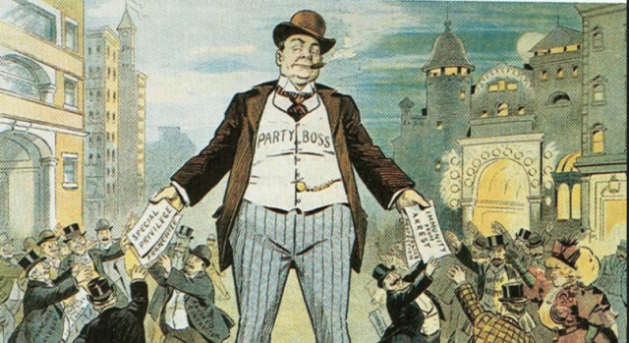Previously published at WGBHNews.org.
As local newspapers shrink or disappear, opportunities increase for politicians and public employees to reach into the cookie jar and help themselves. After all, one of journalism’s most important functions is to act as a watchdog on government. As far back as 2009, the internet scholar Clay Shirky said that he expected to see an explosion of “casual endemic corruption” as more and more small papers shut down.
But how to quantify that? According to a new study, the lack of oversight can be measured by a rise in the cost of government in communities that lose their newspapers. Kriston Capps writes in CityLab that researchers at the University of Notre Dame and the University of Illinois at Chicago found that a municipality’s borrowing costs increase in statistically significant ways in “news deserts” — that is, in places where there is no longer a news outlet that reports on important local issues.
“A local newspaper provides an ideal monitoring agent,” the researchers write in their as-yet-unpublished paper. “Mismanaged projects can be exposed by investigative reporters employed by the local newspaper. When a newspaper closes, this monitoring mechanism also ceases to exist, leading to a greater risk that the cash flows generated by these projects will be mismanaged.”
The ongoing shrinkage of the newspaper business provided the researchers with plenty of data. According to Capps, the study looked at 1,596 papers and found that there were 296 “exits,” a term used to describe newspapers that went out of business, were acquired by competitors, or otherwise lost their relevance.
Although the map that accompanies Capps’ story shows that several newspapers have gone out of business in Massachusetts, the real problem in Greater Boston is depleted resources rather than a shutdown of newspapers altogether. The Boston Globe has gotten smaller as publisher John Henry tries to figure out a path to sustainability. The Boston Herald, an important check on the Globe, is being decimated by its new chain owner, Digital First Media. And GateHouse Media runs the more than 100 community papers it owns in Eastern Massachusetts on a shoestring.
I tend to be skeptical of social science that tries to craft a narrative out of data that could be background noise. But the Notre Dame-Illinois findings appear to be fairly robust. There’s no doubt that government officials — especially those who are corrupt — fear the scrutiny of tough, independent journalism. We already knew we were paying a cost for the decline of the news business. This is one of the first indications that there may be a way of measuring that cost.
***
Unfortunately, the desertification of the news ecosystem continues apace. Another study, scheduled to be released later this month, will show that about 900 communities nationally have lost news coverage since 2004, with the hardest-hit areas tending to be the least affluent.
This new research is being put together by the Center for Innovation and Sustainability in Local Media, based at the University of North Carolina. Veteran journalist Tom Stites, who helped popularize the term “news deserts,” writes about the study for the Poynter Institute. The data will be released in the form of a searchable database and will include demographic information such as household income and poverty rates.
One of the study’s findings, Stites says, is particularly distressing: many of the online-only news projects that have arisen over the past decade-plus to replace or supplement the local newspaper are serving affluent areas rather than poorer communities. Indeed, robust news projects serving low-income cities such as the New Haven Independent, which I wrote about in my 2013 book, “The Wired City,” appear to be the exception rather than the rule.
Stites, a former editor with papers such as The New York Times and the Chicago Tribune, is the founder of the Banyan Project, an ambitious effort to bring cooperatively owned news sites to lower-income communities. Banyan’s first site, Haverhill Matters, is still not fully operational despite many years in the making, though fundraising and planning for a full-fledged launch continue.
***
For a long time, Facebook loomed as the force that news organizations couldn’t live with and couldn’t live without. On the one hand, Facebook and Google were hoovering up more than 90 percent of all new digital ad revenues. On the other hand, publishers were dependent on Facebook for much of their traffic.
Now there are signs that is changing. According to Lucia Moses of Digiday, new statistics from the web analytics firm Chartbeat show that Facebook referrals to news sites are down while direct traffic to news sites is up. Part of the reason is that Facebook in January decided to give a boost to posts from users’ family and friends. But though that may help to explain the decline in referrals, it doesn’t explain the rise in direct traffic.
“The increase in direct traffic matters because it enables publishers to control their own destiny,” Moses writes. “They have more data on reader behavior, which enables them to better target readers with more content and offers for subscriptions and other revenue drivers.”
This is pure speculation on my part, but I think the rise in direct traffic may also be part of the flight to quality we’ve seen since the 2016 election. Digital subscriptions are up at The New York Times, The Washington Post, and regional papers like The Boston Globe, donations have increased to nonprofit news organizations like ProPublica, and listenership has risen at NPR. Word may finally be getting out that social media in general, and Facebook in particular, is awash in fake and unreliable news.


 It’s an observation that has become cliché, but it needs to be made: Without robust local journalism, it is nearly impossible to hold government accountable. Yesterday’s
It’s an observation that has become cliché, but it needs to be made: Without robust local journalism, it is nearly impossible to hold government accountable. Yesterday’s